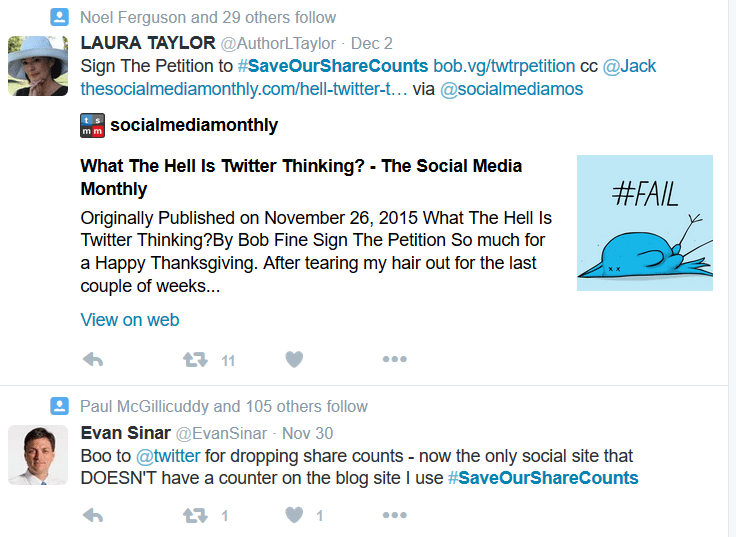
Publishers Balk as Twitter Removes Share Counts
Lorem ipsum dolor sit amet, consectetur adipiscing elit. Ut elit tellus, luctus nec ullamcorper mattis, pulvinar dapibus leo.
Source: Twitter

Two weeks ago Twitter removed share counts from Tweet buttons on publisher sites, and some publishers are upset about the change, reports DigiDay. Some of those publishers have even launched a campaign – #SaveOurShareCounts – to protest the loss of share counts. An online petition has been started as well, though it appears to only have 17 signatures so far.
Source: Twitter

Twitter announced the change in an October 6 blog post, “Hard decisions for a sustainable platform.” In the post, Michael Ducker, group product manager, said Twitter wanted a predictable, dependable platform and it has to make choices about which products and public APIs it supports. Apparently, Twitter share counts didn’t make the cut.
Ducker also explained how the Tweet button counts work. The button counts the number of tweets that have been tweeted with the exact URL specified in the button. Also:
- Tweet count does not reflect the impact on Twitter of conversation around a publisher’s content.
- It doesn’t count replies, retweets, quoted tweets or variants of the URL.
- It does not reflect that some people tweeting URLs have more followers than others.
In other words, the tweet counts are not 100% accurate. They only measure one metric. Nonetheless, some publishers are upset.
In a recent DigiDay article, Slate’s vice chairman Dan Check said, “I guess we got caught with our pants down. We want that count back. It’s meaningful to us. Having share counts along comment counts is a strong way to underline that there’s a conversation around what we’ve written. We want to signal to readers that that conversation is happening.”
Don Sturgill wrote about Twitter’s decision for Warfare Plugins:
“Off the cuff, that may not sound like an earthshaking development – but the potential ramifications are huge. It could even signal the beginning of the end for social media metrics as we know them or it may signal a giant step towards a paywall-anchored internet.”
Sturgill said these are the most likely outcomes:
- Bloggers won’t be able to show visitors how many times their posts have been shared which could lead to less interaction and fewer shares.
- Online professionals who get paid by brands won’t be able to prove to advertisers how popular they are online or, what Sturgill calls Social Proof.
- Third-party app developers without access to share counts may lose functionality within their apps, causing them to lose subscribers.
Jonathan Long, a contributor for Entrepreneur, said the removal of share counts was a terrible one because publishers are frustrated, some websites are already removing Twitter as a sharing option, and there’s a possibility of fewer tweets because people are more likely to share when they see how often a blog post or article has already been shared, something Long calls the “cool effect.”
There is a lot of speculation about why Twitter has really made this change, says Warfare Plugins, including Twitter’s need to generate additional revenue, a desire to cut expenses, competition with Facebook and other platforms, and forcing users and developers to use Twitter’s preferred APIs, tools and vendors.
This change may not be permanent, however. Twitter has given itself an out. On November 20, Twitter updated its October 6 post, saying they welcome feedback and will use input received over the next 60 days to incorporate suggestions and improve tools to better integrate Twitter into apps and websites.
Insider Take:
It seems like Twitter has bigger reasons than technology improvements for doing away with share counts, but at best, we can only speculate. Some publishers are upset, but others are not because they see share counts as only part of the metrics picture. They rely on other tools including Adobe Analytics, Facebook Insights, and Twitter’s own analytics dashboard to help them frame what content is most popular.
We think Twitter will gather user feedback and perhaps find some middle ground to accommodate publishers, besides steering them to Twitter-owned Gnip which is cost prohibitive. In the meantime, publishers who previously relied on Twitter share counts will have to get their data another way – or develop other ways to identify Twitter’s impact on sharing their stories. Nimble publishers and their technology teams will adapt.
The story here is probably much bigger than it appears right now, but over the next 60 days, we expect to learn more about Twitter’s motives, and we’ll see how publishers are adjusting to the change. We’ll keep you up-to-date on future developments.





